18 Feb 2019

The patient three weeks post-surgery.
Crop burn is a commonly reported condition in hand-reared nestlings or convalescent adults that require crop feeding to be brought into good health. It is not uncommon for them to be fed excessively hot formula; the ideal food temperature for crop feeding is between 39°C and 41°C, and use of a thermometer is advisable. Food should also not be warmed in the microwave since this can produce “hot spots”. If a microwave is used, the food must be mixed thoroughly to ensure a consistent, appropriate temperature.
Affected birds may present with a wet skin patch over the crop up to 10 days after the incident. In severe cases, such as the one discussed here, necrosis of the crop wall and skin may occur. This will eventually lead to a fistula formation, which may be repaired once the viable tissue can be differentiated from the necrotic tissue.
In this case report, the author describes how the patient’s crop was repaired in three different surgical procedures after severe crop necrosis was reported. The patient recovered without any problems from each of the procedures and was interested in feeding straight away.
An 11-week-old, 360g African grey parrot was presented suffering from a severe crop burn that occurred 12 days prior; the crop had cracked and started to leak through.
The case was referred to the author by another practice that did not have the required knowledge for this kind of avian emergency. The parrot had been dispensed enrofloxacin and meloxicam by the referral practice.
The patient was a single bird that had been hand-reared indoors and just been rehomed. The parrot had been crop fed very hot hand-reared formula, causing an extensive deep burn to the entire crop area, leading to necrosis. However, it was still able to eat seeds – some of which started to come through the necrotic burned skin, as well as water.
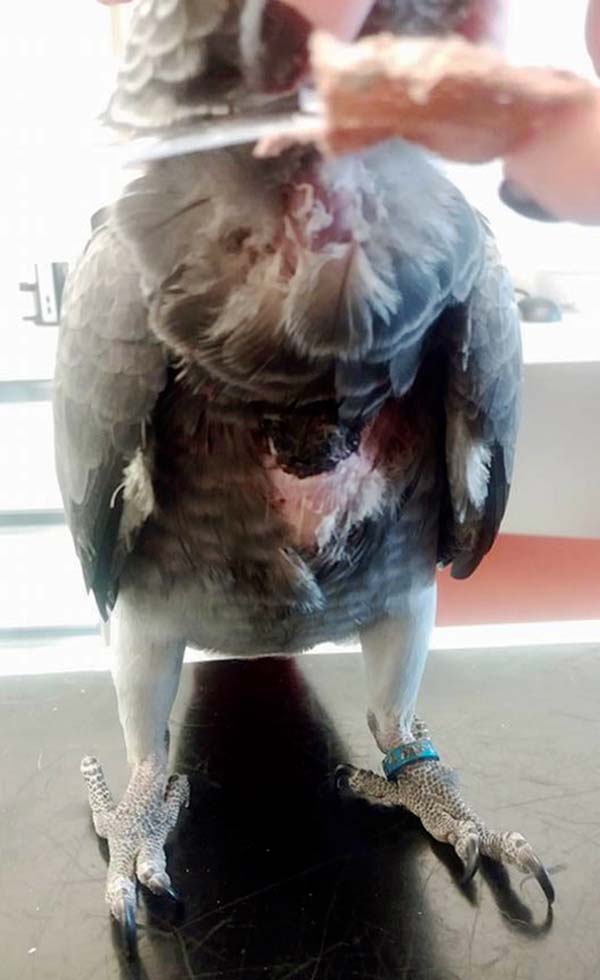
The patient was seen by another vet, who was unable to carry out surgery, but had started it on antibiotics (enrofloxacin) and pain relief (meloxicam). The parrot was presented to the author the next day.
On examination, the patient was alert, responsive and its body condition was good – bodyweight was 360g, mucous membranes were nice and pink, and feather quality was good. On close examination of the crop area, the skin appeared thickened and necrotic, and had started to detach from the body wall – allowing seeds and water to pass through.
Extensive discussions with the owner followed about the potential for two surgical procedures – first, to try to debride as much dead skin as possible, and, second, at a later stage, to try to reconstruct the crop.
Even though a success rate of less than 50% was predicted – taking into consideration the parrot’s energy and strength while being examined – the decision was taken to proceed and surgery was scheduled for the same day.
The patient was diagnosed with crop burn.
The prognosis was very poor to guarded.
The patient was starved for one hour prior to surgery. Since enrofloxacin had already been started and was due; 5.4mg enrofloxacin IM, 0.12mg meloxicam IM and 0.015mg buprenorphine IM were administered perioperatively. Induction was achieved using 5% isoflurane in oxygen – delivered via a face mask.
The patient was intubated and placed in dorsal recumbency, with the head slightly elevated to facilitate the procedure. The aim of the operation was to debride the dead, necrotic area and suture the opening to the crop to prevent leakage, until the viable skin and muscle layers were more defined.
The chest area was gently plucked and skin aseptically prepared for surgery using diluted iodine. When the area was more closely examined and assessed, the dead skin was lifted back to reveal a 6cm in diameter hole, which also exposed part of the breast bone; the crop muscle layer had been destroyed by the aggressive burn. The owner was updated at this point and euthanasia on humane grounds was discussed, but it was decided to go ahead with the procedure.

Most of the necrotic skin, caudal to the burned skin, was resected and the healthy edges debrided. The rest of the necrotic skin was left in place to act as a bandage since the hole was too big for a skin graft to be carried out at this point: this “bandage” would prevent water and food leakage through the skin.
The caudal aspect of the burnt skin was sutured using polydioxanone suture (PDS) 3.0 single interrupted pattern. Recovery from anaesthesia was uneventful, and the patient started eating good-quality seed mixture and soft foods after the procedure. The patient’s bodyweight was recorded at 360g. The author predicted the necrotic scab would start to lift within 7 to 10 days, so a follow-up appointment was scheduled a week postoperatively.
Seven days after surgery, the cranial aspect of the scab started to lift, allowing water and food to pass through the crop, and surgery to investigate was scheduled that day. Pain relief was administered during the perioperative period at 0.12mg meloxicam IM and 0.015mg buprenorphine IM. Antibiotics had already been given at home.
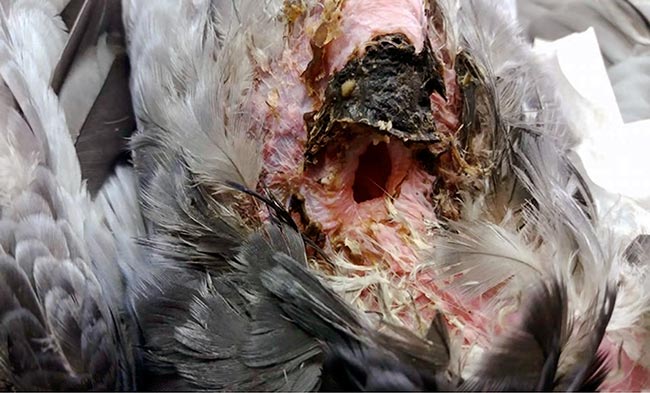
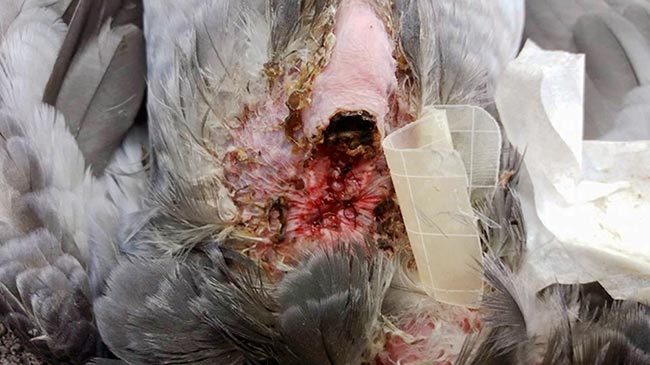
An examination under general anaesthesia was carried out and, as expected, the dead skin had shrunk, leaving a significantly smaller fistula in the crop of around 2cm in diameter. Residual seed was removed from the crop and the surrounding skin was aseptically prepared for surgery using diluted iodine.
The demarcation between viable and non-viable tissue was evident, so the fistula was debrided and the muscle layer separated from the skin. These were both sutured in two separate layers using 4.0 metric monofilament absorbable material for the crop (PDS) and 4.0 metric non-absorbable material for the skin. Recovery, again, was uneventful. Diet following the procedure consisted of bland foods and softened seeds. The patient’s bodyweight was recorded at 390g.
Follow-up examinations were carried out on days two, five and seven postoperatively. No problems were identified and recovery was proceeding well until day 10, when the author received an update from the owner stating water was leaking through the patient’s crop again. An emergency appointment was scheduled and an investigation under general anaesthesia carried out.
On examination, a small necrotic area of skin over the stitches was reported, indicating that a small leakage had occurred while healing. The skin was aseptically prepared for surgery with diluted iodine.
Pain relief and antibiotics were administered IM perioperatively using 0.12mg meloxicam, 0.015mg buprenorphine, and 58.5mg amoxicillin and clavulanic acid. The necrotic area was debrided and re-opened, creating a new small fistula to enable good apposition, and healing of the muscle and the skin layers.
Both layers were sutured separately using a double continuous inverted pattern for the muscle, with 4.0 metric synthetic monofilament absorbable material (PDS) and a simple interrupted pattern for the skin, using 4.0 metric non-absorbable material. Recovery from anaesthesia was, once more, uneventful. The patient’s bodyweight was recorded at 415g.
Follow-up examinations were carried out on days two, five and seven postoperatively. The diet this time consisted of Harrison’s hand-rearing formula for 10 days to decrease trauma to the sensitive muscle layer of the crop, and speed recovery and healing.
Follow-up examinations were carried out on days two, five and seven postoperatively. On day eight, the owner reported suddenly the patient was inappetent and weak, collapsing soon afterwards and dying.
Trying to make breeders and inexperienced owners aware when hand-rearing nestlings or crop feeding a parrot, the optimum temperature range of the hand-rearing formula must be between 39°C and 41°C. If a microwave is used to warm the food up, it must be thoroughly mixed to prevent “hot spots”.
Owners suspecting crop burn must bring the bird to an avian veterinarian as soon as possible to prevent further complications.
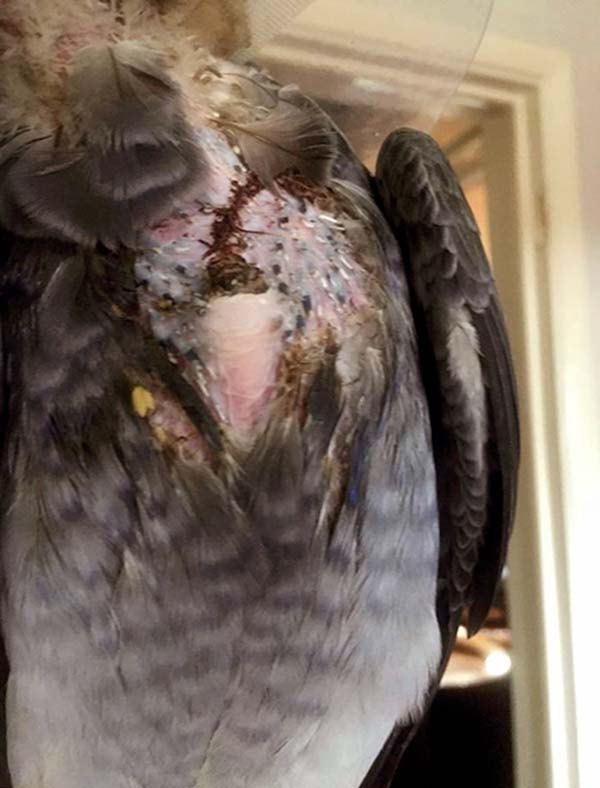
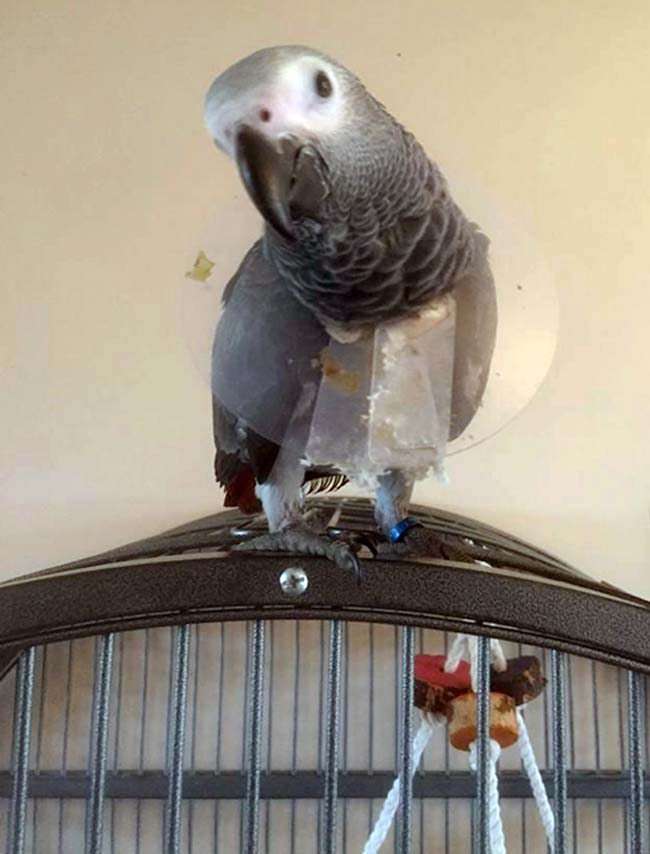
The ingluvies of the bird is a part of the cervical oesophagus that enlarges near the thoracic inlet, with a sac-like shape where the food is stored; it is generally referred to as the crop. In its empty state, the crop is a teardrop or U shape, and lies right and ventral to the trachea. Not all avian species have a crop – some that do not include gulls, penguins, toucans, owls, and many species of duck and goose.
Among the pathologies that can affect the crop of psittacines kept in captivity, one of the most common is crop burn. In most cases, a third-degree burn develops, affecting the thin muscle and skin layers of the crop as a result of the parrot being fed hand-rearing parrot formula that is too hot.
In the case under discussion here, the damage to the crop was so severe that a hole of around 6cm in diameter, with thickened necrotic edges, was reported. While the patient was very bright, energetic and interested in food at all times, the prognosis given to the owner at this stage was poor to guarded.
Crop burns can be easily treated when the patient is in good health. Surgical repair should be deferred by between 1 to 10 days after the incident occurred so the necrotic material can be differentiated from viable tissue and, generally by this time, a fistula has developed. In the meantime, pain relief and antibiotics should be dispensed to the patient to prevent further complications.
In this case, the parrot presented 10 days after the incident had been reported once the owner had noticed food and water leakage through the necrotic skin. The patient had already been started on full-spectrum antibiotics and pain relief by another vet.
Once the fistula has formed and the muscle layer is well differentiated from the skin, the crop can be surgically repaired. Following induction and intubation of the patient, the skin is surgically separated from the crop wall. The crop wall is closed using a continuous inverted pattern with monofilament absorbable material. A single interrupted pattern is used to close the skin with monofilament non-absorbable material.
Postoperative complications can occur if the internal suture breaks down and leakage of food/water filtrates SC, causing skin necrosis and the fistula to re-open. In some cases, a pharyngostomy tube may be inserted to help feeding. This patient’s crop was severely necrotised. The first surgical procedure involved closing the skin opening that was leaking food and water, and re-attaching the thickened necrotic skin so it could act as a protective bandage until the fistula developed, reducing the initial wound in size.
The second procedure, which was performed seven days postoperatively once the fistula had developed, involved repairing the crop to return the patient to normality. However, due to the fragility of the tissue, on day 10 after the second procedure, the wound had broken down and a small area of necrosis was reported.
The patient was booked for a third procedure in which the wound was debrided once more and the crop layer closed separately from the skin. Close monitoring was carried out postoperatively. In this case, a pharyngostomy tube was not required, since the patient was feeding well and gaining weight steadily.
Systemic antibiotics and pain relief were dispensed and administered throughout the duration of the treatment. Postoperative checks were carried out on days two, five and seven following the final surgery. The patient recovered from all these procedures (all carried out within 1.5 months) uneventfully, but deteriorated and died a week after the final procedure.
As in this case, a good chance exists of returning an avian patient to 100% functional status when the problem is managed and corrected early. The prognosis in this case was poor and, even if the patient recovered after all the procedures, multi-organ failure could have been caused by ongoing treatments.
To prevent this common problem recurring, it is paramount new parrot owners and breeders are made aware of the gold standard practices when hand-rearing psittacines. Correct food preparation is critical: avoiding use of a microwave when possible, keeping the hand-rearing formula between 39°C and 41°C and bringing the patients to see an avian vet as soon as crop burn is suspected. Avian patients generally heal very well and respond quickly to support care.
The author acknowledges Ross Brown – professional proofreader, business writer and editor – for kindly proofreading this article.